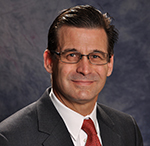A look back at last winter with Ferrell North America’s VP of transportation
Last year’s brutal winter had a lasting impact on a number of propane retailers and the drivers hauling their propane. With this winter heating season underway, let’s look back on the winter of 2013-14 with Jimmy Ainsworth, vice president of transportation for Ferrell North America.
LP Gas: Ferrell North America sources propane from more than 180 different terminals. How many of those terminals did last winter impact? Did Ferrell North America have to seek alternative terminals or sources for product?
Ainsworth: We not only are serving the internal customer, Ferrellgas and Blue Rhino, but we have external transport customers. We were providing service and supply for others. There are 180-plus terminals we use nationwide throughout the year. With a nationwide footprint, we’re taking delivery of propane from essentially the entire supply infrastructure nationwide. We might lean on some terminals more than others, but we’re tapping into the entire nationwide footprint of supply terminals.
[Last] winter, we faced new challenges. The scope and intensity of [last] winter was greater. It really started in late October with a record grain drying season, and was followed by record cold from California to the Rio Grande to the Great Lakes. It never let up.
Challenges arose because of the duration and length of wintertime. We were able to get product, but we were faced with more allocation at more terminals across the country than you might typically see at one time. We were faced with significantly longer lines and wait times. We’ll wait in line every year when things are busy. [Last] year it seemed like practically every place had reduced volumes due to the higher-than-normal winter demand.
We saw anywhere from 12 to 36 hours of trucks waiting in line at the very peak of the season. We were able to exercise our relationships and our contracts; we were able to tap into the total supply terminal infrastructure. But we were going longer distances.
An example would be us taking Conway, (Kan.), product to Minnesota or Wisconsin. That’s not your typical length of haul. But in order to meet demands and ensure we were constantly moving and flowing product, we found we had to engage in hauls such as that.
It was a constant daily juggling act of making sure we were making use of everything available and constantly rebalancing, as well as working with our drivers and communicating regularly. Knowing where there were delays; what those delays were; and how those delays would impact the schedule was important. Communicating to the customer that loads are coming, that they may be delayed and here’s why was important, too.
LP Gas: What impact did last winter have on propane transport drivers, both physically and mentally? How about the widespread hours of service (HOS) waivers and their physical/mental impact on drivers? What sorts of stories did you hear from the road? How did their overall experiences compare with previous winters?
Ainsworth: We have some outstanding personnel who have a high sense of mission to the customer, whether it’s Ferrellgas retail or the wholesale customer. They know if they don’t show up that folks are affected. They take the job very seriously. They work extremely hard to do their jobs well. Our driver has been with us, on average, about 10 years. There’s a lot of tenure there, and we work hard to get good folks behind the wheel with good training.
[Last] winter, our drivers never seemed to catch a break. They [were] out there waiting in lines. It [was] wearing on them and it [was] fatiguing. We saw 30 states or more at the peak of the season with HOS waivers. I’m sure other companies, dating back to early November [2013], had transport drivers operating continuously into January [2014] almost non-stop.
As the winter progressed, I could tell drivers were getting tired and stressed at various times from day to day. At the same time, I could hear in their voices a sense of mission, that customers are counting on us and that we’re going to get the job done. Their attitude was that if you need me away from home for a month, that’s what I’m going to do. That’s what we’re constantly hearing.
If a driver called up and said, “I’m exhausted,” that’s helpful and encouraged us to ensure we operate safely where we then find a truck stop for a rest break. We rebalance, reassess and communicate updated delivery ETA to the customer.
LP Gas: Has Ferrell North America been able to quantify how many more miles transports drove last winter? How about how many gallons were delivered during the winter of 2013-14, at least compared with traditional winters?
Ainsworth: We delivered about 3,000 more loads overall during the November-December-January period than the prior-year period. Generally, we had to haul longer distances to meet customer needs. When you’re going a longer distance than you typically plan for, your original expectations obviously change. If an interstate in Indiana is closed or if we blow a tire, those are new challenges.
LP Gas: What were the greatest challenges you faced in your role last winter?
Ainsworth: Within our transportation department, the key component is the driver behind the wheel and making sure their job gets done timely and safely. But here in our office in Overland Park, (Kan.), eight people take the customers’ orders and set up a schedule. They’re communicating that dispatch to our drivers and to our common carriers who partner with us on overflow – and we do retain a large number of external common carriers to ensure we have access to resources and a balanced approach when demand does surge.
Our folks here managing dispatching and scheduling aren’t in the elements and the muck. But there is a mental challenge from November to March handling dispatch and making sure trucks are showing up. The longest period of no break we’ve seen in my 17 years doing this was [last] winter, so we’d keep them fresh, pumped up and aware of customer needs. Human nature is human nature. Folks get tired. We’ve just got to make sure we get breaks as required and we do what we can to keep them fresh.
Honestly, we had to reinvent our playbook. We have assets, so what can we do to develop more assets on the fly to allow us to accommodate surging customer needs? The biggest challenge was in working with partners, common carriers and retailers to create more resources on the fly to increase delivery load each day. But where can we find these resources? That was a great challenge. The mission is to take care of customer needs. It’s finding ways to get the job done.
LP Gas:What’s the greatest takeaway from the winter of 2013-14 that you can apply to future winters?
Ainsworth: Everyone in the industry is always going to analyze every season and how to better prepare. From a Ferrell North America perspective, one thing we will continue to do is take propane deliveries from terminals throughout the year. We continuously load product throughout the year for our retail system in order to earn our allocation throughout the year and to maximize our available supply for wintertime.
As things tighten up and allocation manifested [last] winter, that benefited our company and helped us maximize as best we could the normal supply for customers out there. We’ll be looking at the array of challenges we’ve faced and working that into our contingency planning so we can continuously improve. We are always hoping for the best but planning for the worst.

















